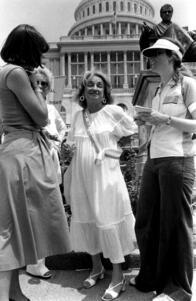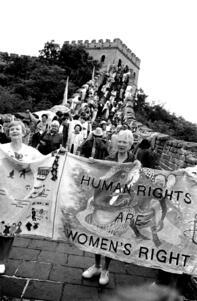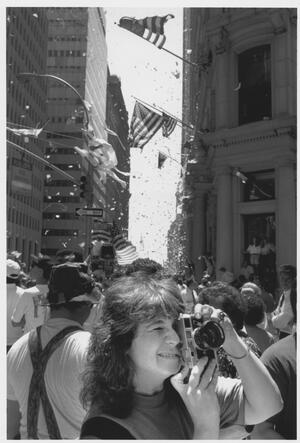Joan Roth
I had been involved in the women’s movement since its inception, particularly as it applied to my own life, and then as a photographer. As such, I was able to integrate what women were striving for with my work and to play a part in the revelation and documentation of our history by photographing momentous occasions. Two examples:
On July 9, 1978, 100,000 women wearing long white dresses and carrying purple and gold banners to commemorate the colors of the suffragists marched on Washington with Betty Friedan (pictured here) and other feminist leaders. They marched to support an extension of the deadline for ratification of the Equal Rights Amendment (ERA). In 1923, Alice Paul, renowned suffragist and leader of the National Women’s Party, had authored the ERA, which would guarantee women protection against sex discrimination, and began campaigning for its introduction into Congress. In 1971, under the sponsorship of Congresswomen Bella Abzug and Martha Griffiths, Congress finally passed the ERA, and although it was immediately ratified by 25 states, no additional states accepted the amendment in the prescribed seven-year period. The marchers were successful in extending the ratification deadline for another three years, but not in passing the ERA, which died in 1982.
1975 was declared “The Year of the Woman” by the United Nations, which then sponsored a series of yearly international conferences on strategies for the advancement of women, to be implemented in the upcoming “Decade of Women.” I was awarded grants to photograph the Third and Fourth United Nations International Women’s Conferences in Nairobi and Beijing. These photographs would be published and exhibited throughout the world.
For the Fourth World Conference held in Beijing, and the parallel Non-Governmental Organization (NGO) Forum on Women in Huairou in August-September 1995, nearly 59,000 women traveled to China to make it the largest conference in United Nations history. An estimated 30,000 women attended the NGO Forum, during which busloads traveled to the Great Wall to make a statement at this historic site, one of the most visible spots in the world.
Here we unfurled banners, one of which read, “Human rights are women's rights,” the theme of the conference, as a gesture to China’s government – where women lived without rights – and to let the world know that not only had the women arrived, they would win this struggle that had already endured longer than the Wall’s 2,000-year history. For me, this occasion was more than an opportunity to preserve another moment in history. Standing on top of the world, with a true and equitable representation of its women, seemed a harmonious interchange between dreams and action, work and belief.
Joan Roth is a photographer whose work has been published and exhibited throughout the world. Her passion lies in visually conveying the grandeur of ordinary women. Born and reared in Detroit, Joan Roth came to New York in 1962. During the early years of the women’s movement, she was part of several important consciousness-raising groups in East Hampton, New York, and in New York City, and started other groups across the country. Roth has photographed the women's movement since the early days. She photographed the UN International Conferences on Women in Nairobi and Beijing, and in 1994, she began documenting Veteran Feminists events. Roth traveled worldwide to publish Jewish Women: A World of Tradition and Change, the first book about Jewish women - including in cultures such as Ethiopia, India, and Yemen - by a Jewish woman photographer. She also photographed women in Baltimore and Seattle for the Jewish Women’s Archive’s oral history project, Weaving Women’s Words.






kudosMObjectively speaking, even though I am her sister..
the photo in Lilith Aug 2 edition, of Bryna Wasserman is such a joy... It captures her love, enthusiasm, ans spirit all at once.